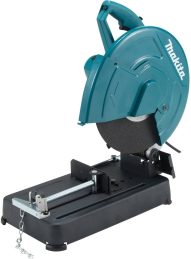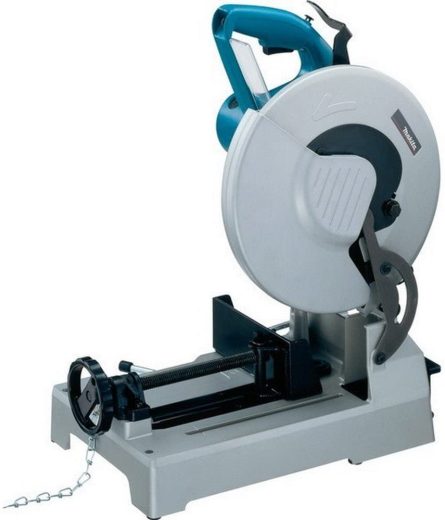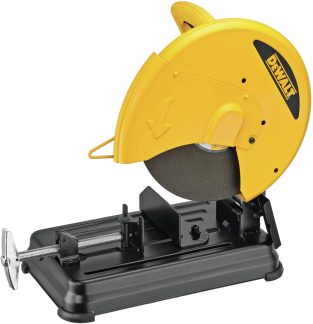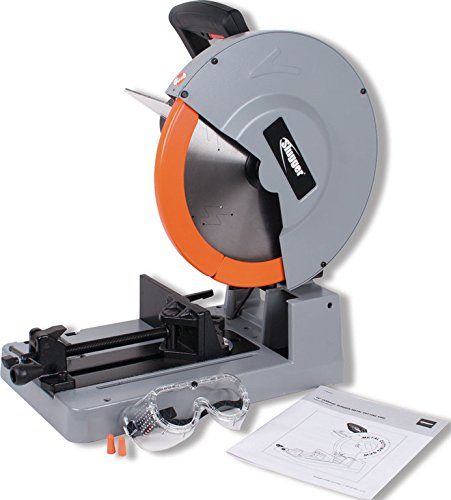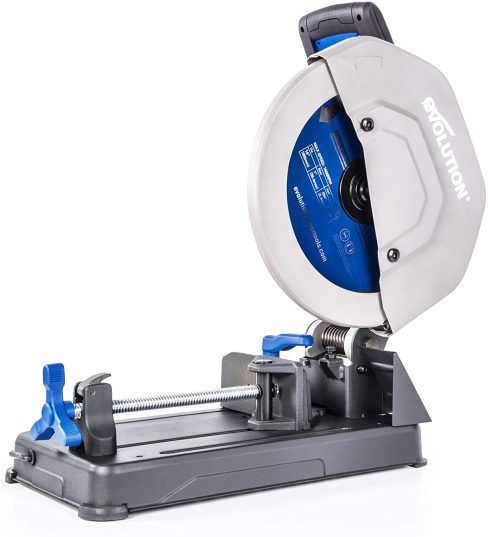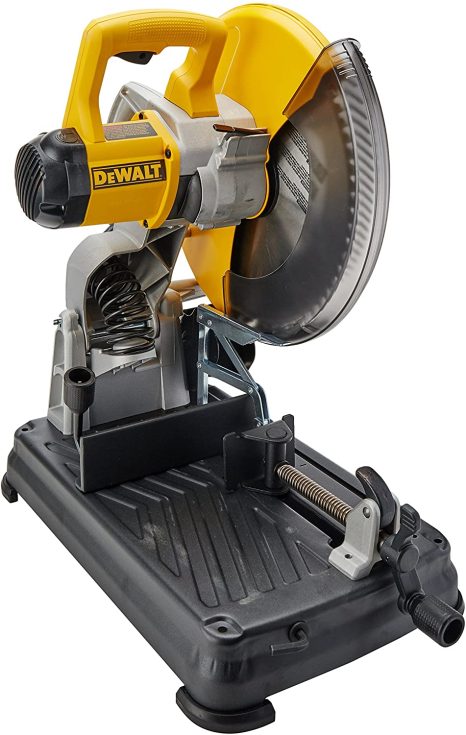Handy Tool Adviser
The Best Chop Saw for Metal | Top 7 Rankings
Updated: 06-December-2025
The choice of the best chop saw for cutting aluminum, iron, steel or any other metal requires comparing different options available in the market and online marketplaces to reach a sound buying decision. Many renowned brands are making good quality chop saws with different power and feature combinations.
In our today’s post, we have compared some popular models to find the best chop saw for individual requirements such as for home use and for tough applications. So let’s not keep you waiting any longer and begin with the analysis.
Don't forget to read an interesting piece we've written at the end of the rankings on comparing cutting wheel chop saws with abrasive wheel chop saws. We've also discussed in detail what you should look for in a chop saw towards the end of the article.
Ranking the 7 Best Chop Saws
Our recommendations for the best chop saw are based on a combination of performance, specifications, features, safety features, user feedback and ergonomics. We selected those chop saws for competition that are easily available for purchase online and compared them on the referred parameters. Let us present you the results without further due.
7
Makita LW1401
14" Cut off Saw
Our Rating: 8.2 / 10
Makita chop saw LW1401 is another great model by Makita powered by a 15 amp motor running its abrasive wheel at a maximum of 3800 RPM. It can cut 5” round stock and 4-11/16” square stock with a very light weight design weighing at only 37 lbs.
It cuts with a lot of sparks like any abrasive wheel type chop saw but gives adequate cutting performance on aluminum, iron and steel making it worthy of a recommendation.
Makita delivers the LW1401 with an abrasive cut off wheel to get you started straight away as soon as the package is received.
Pros
Shortcomings
6
Porter-Cable PCE700
14" Chop Saw | Best Chop Saw for the Money | Under $150
Our Rating: 8.3 / 10
Porter Cable chop saw PCE700 is an abrasive cutting wheel type chop saw powered by a 15 amp motor to a speed of 3800 RPM. It has the capacity to cut 4-7/8” round stock and 4-1/2” square stock.
It has a light weight design and delivers overall good performance in majority of everyday cutting applications. It may not be packed with the most ergonomic features but its low price point justifies its value making it the best chop saw for the money.
It will easily work on aluminum extrusions, tube steel, angle iron, rebar and 1/2" flat stock, to give a few examples. Porter cable delivers the package with abrasive wheel to get you started with your work as soon as you receive the package.
Pros
Shortcomings
5
Makita LC1230
12" Size | Best Small Metal Chop Saw | Best for Home Use
Our Rating: 8.7 / 10
Makita does not need any introduction as a power tool brand and this Makita chop saw LC1230 reflects Makita’s commitment to good quality and performance. It is powered by a 15 amp motor to 1700 RPM and is a dry cut or cold cut type chop saw i.e. leaves the cut piece cold to the touch.
It is a 12” chop saw with cutting capacity of 4-1/2” round stock and 3-15/16” square stock that might not be enough for professionals and contractors, however, fulfills majority of requirements of homeowners using the tool for smaller jobs such as cutting angle iron and aluminum frames.
To give an idea of its cutting ability, it will cut anything from the everyday 2x2x1/4" thick box tubing, 2x3x3/8" thick angle iron,
4x1/8" mild steel flat bar, 2" square steel tubing and channel of 3/16" thickness to the more occasional 3x4" 7075 Solid Aluminum stock and 2" SCH 40 pipe.
We found its blade guard design to be the among the best in competition second only to Fein chop saw. With a 60 teeth carbide tipped blade and safety goggles included in the package, we found it to be the best chop saw for home use.
Pros
Shortcomings
Tidbit
We used the term SCH 40 Pipe above. It refers to schedule 40 pipe and is a convention used in United States to indicate the wall thickness of the metallic pipe (generally galvanized iron or steel). There are 14 schedules defined by American Society of Mechanical Engineers (ASME) which specify wall thickness of metallic pipes and their corresponding pressure ratings. A SCH 80 Pipe would have greater wall thickness and pressure rating that an SCH 40 Pipe.
4
Dewalt D28730
14" Size | Best Abrasive Chop Saw
Our Rating: 9.0 / 10
Dewalt chop saw D28730 is an abrasive type chop saw that uses abrasive disc instead of a cutting disc. It is powered by a 15 amp motor running the blade at 3800 RPM and has the capacity to cut 4-7/8” round stock and 4-1/2” square stock.
Dewalt backs this tool with its extensive 3 year warranty, 1 year free service and 90 days money back guarantee, and packs the chop saw with an abrasive wheel to get you started as soon as you receive the package.
From the routine angle iron, flat bar and square tubing to railroad spikes and black industrial pipes, this chop saw gets the job done.
From cutting flat bar to angle iron, it gives solid performance making it the best abrasive wheel type chop saw on our list.
Pros
Shortcomings
3
Fein Slugger MCCS14
14" Size | Best Chop Saw for Beginners
Our Rating: 9.5 / 10
Fein Slugger chop saw is powered by a 15 amp motor running the tool at 1300 RPM with a cutting capacity at par with Evolution chop saw and second only to the Dewalt that is first on our list.
Fein chop saw features a unique design of blade guard where the guard is divided into two sections that open and close in a scissoring manner covering the entire circumference of the blade and providing more protection to the user than traditional blade guards.
It has shown great performance in cutting tough materials burr free that are cold to the touch like other top rated saws on our list. Fein packs the tool with a mild steel blade as well as eye protection safety goggles.
Whether you are a millwright tradesman, an automotive enthusiast who fabricates off-road vehicle items or a home owner making deck posts, this chop saw will serve your needs.
From 2x2" tubing of 1/8" thickness, 1-3" square tubing, flat bar, 1-1/2" pipe, 2" angle iron of 1/8" thickness to 1.5" square angle of mild steel of 1/4" thickness and aluminum solid stock, this chop saw will get the job done.
Overall, Fein chop saw MCCS14 is one of the best chop saw out there and it is second to Dewalt and Evolution on our list by a small margin.
Pros
Shortcomings
2
Evolution S355CPSL
14" Size | Best Chop Saw for Steel
Our Rating: 9.6 / 10
Following Dewalt closely on our list, is the Evolution chop saw S355CPSL. It is powered by a 15 amp motor to a top speed of 1450 RPM. It has a premium feel to its build – very solid with no loose parts.
Apart from the blade Evolution gives with the package, it also comes with a V-block to hold rectangular stock in an angular position that Evolution recommends for improving blade life.
To give a few examples of its utility, it cuts 11 gauge tubing of 1.5x2" like a hot knife through butter. It will make hundreds of cuts on 3" square tubing of 1/4" wall thickness without any effort. It wouldn't shy away from cutting 2x2" square stock of mild steel, 4x4" I-beams and everything from pipes, bars and t-tracks to aluminum extrusions.
Evolution has packed this saw with a ton of use features including a chip tray, depth stop screw, on-board wrench, tool-free fence adjustment and quick lock vise.
From aluminum to iron and steel, this saw goes through tough materials like a champion leaving burr free finishes that are cold to the touch and produces little to no sparks during the cut making it the best chop saw for tough materials on our list.
Pros
Shortcomings
1
Dewalt DW872
14" Size | Overall Best Chop Saw for Metal
Our Rating: 9.7 / 10
Number one on our list is the Dewalt chop saw DW872. Powered by a 15 amp motor running the blade at 1300 RPM, it has the largest cutting capacity of any saw on our list. You can use this saw to cut 5-3/16” round stock and 4-3/4” square stock.
It is a dry cut saw, also referred to as cold cut, that means the workpiece is cold to the touch after a cut. It also produces very less sparks when cutting a workpiece – most noticeable when compared to abrasive saws.
The translucent blade guard gives a good visual of the blade in action and is not at all flimsy. The compression spring loaded cutting head gives you a very smooth feel when you pull the head down for cutting.
While quick lock vise is featured on many other chop saws as well, the tool free miter adjustment of fence is a big time saver - not a common feature in other models. It is also the only saw to have an auxiliary vertical clamp to hold the stock from top as well.
To give a few examples of its utility, it will cut 1/8" to 3/4" flat bar, 2" square tubing with 3/16" wall thickness, 4" steel tubing with 1/4" wall thickness, 5/8" tube stock, 6" wide and 1/4" thick strap, small bore pipes, angle iron and mild steel shaft.
Overall, its all rounded performance on aluminum, iron and steel combined with good ergonomics and Dewalt’s solid 3 year warranty, makes it the best chop saw for metal on our list. The package includes carbide tipped blade to get you started.
Pros
Shortcomings
Metal Cutting Wheel vs. Abrasive Wheel Chop Saws – Which One to Use?
There are two types of chop saws in the market. One type uses an abrasive wheel and the other uses a cutting blade. Check the illustration below ad then read ahead:
Side by Side Demonstration of Cutting Blade vs. Abrasive Wheel Chop Saw
(Video Credit: MakitaVideos YouTube Channel)
The first difference is that abrasive wheel chop saws run at higher speed (RPM) than cutting blade chop saws. The typical speed for abrasive wheel chop saws is 3-4,000 RPM whereas it is 1-2,000 RPM for cutting blade chop saws.
Owing to their lower cutting speed and reliance on cutting action instead of abrasion, cutting blade chop saws cut cold while abrasive wheel chop saws cut hot. It means that a workpiece cut by abrasive wheel is too hot to the touch while a workpiece cut by cutting blade is not hot to the touch.
The difference is because abrasive wheels rely on friction to remove material of the metal being cut. Friction causes heat and raises temperature of the metal to a high degree. Abrasive wheels also produce sparks during cutting while cutting wheels don’t.
You’d intuitively assume that abrasive wheel chop saws would cut the metal quickest because they operate at higher speed. However, it is actually opposite. Cutting blade chop saws cut workpieces faster than abrasive wheels.
The reason for quicker cutting is that the cutting wheel cuts while abrasive wheel rubs. Cutting wheel removes chips of metal with each rotation of each cutting teeth. Therefore, the blade is able to cut its way through the thickness in less time.
On the other hand, abrasive wheels wear off the metal being cut and get worn out in the process themselves. This wearing off action takes it longer for the abrasive wheel to go through the entire thickness of the workpiece. The same wear raises temperature of the metal being cut.
Finally, abrasive wheels don’t leave as much smooth of a finish as cutting wheels. They leave a burry surface finish. On the other hand, cutting wheels generally leave a smooth burr free finish.
Based on above advantages of the cutting wheel chop saws, they are preferred over abrasive wheel chop saws. However, is there any benefit associated exclusively with abrasive wheels? Yes.
Abrasive wheel chop saws are able to cut harder materials like hardened steel and stainless steel. While cutting wheel chop saws can also do it with the right blade and the right chop saw, abrasive wheels are preferred for hard metals owing to their higher reliability in cutting harder steels.
What should I look for in a Chop Saw?
You should consider the following main points when choosing a chop saw for metals,
What size stock will you be cutting?
The first consideration should be the cutting capacity. Different chop saws have different cutting capacity for example the largest cutting capacity in our research is of Dewalt DW872 that can cut 5-3/16” round stock and 4-3/4” square stock. It is closely followed by Evolution S355CPSL and Fein Slugger MCCS14 both of which cut 5-1/8” round stock and 4-3/4” square stock.
To choose the right size, just jot down the stuff that you will be cutting and also note the size. If you will be cutting 5” iron pipes, you would need a chop saw to handle that size, however, if you will be cutting 2” angle irons, you don’t need such a large size. Even a smaller chop saw such as Makita LC1230 would be sufficient with its maximum round stock capacity of 4-1/2” and square stock capacity of 3-15/16”.
Material Clamping Ergonomics
Every chop saw has a vice for holding the job in position firmly and design of that vice is very important. Clamping mechanism must be easy to clamp as well as release the material while providing a firm grip at the same time. All the chop saws that we have reviewed feature quick release vise that is a must thing to look for in a saw. It allows you to clamp as well as release the workpiece effortlessly.
This clamping system may also be augmented by some special features. For example, Dewalt DW872 features a vertical clamp in addition to the quick release vice that puts pressure on the material from the top as well thereby improving the overall clamping grip of the tool.
Similarly, Evolution S355CPSL comes with a V-block that augments the existing vise with a fixture to hold square stocks in an angled position improving the blade life.
Another nice feature in the clamping system is the mechanism of adjusting the angle of fence for miter cuts. While most of the chop saws have an on-board wrench to loosen a nut and adjust the angle, some saws like the Dewalt DW872, Evolution S355CPSL, Fein MCCS14 and Makita LC1230 as well as LW1401 have tool free angle adjustment of fence making the job quicker.
Storage & Carrying Convenience
There are two important aspects or features to look for with respect to storage and carrying convenience of your chop saw. The first is the weight of the tool. A lightweight design will be much easier to carry.
Weight varies from model to model, for example, lightest chop saw in our research is the Dewalt D28730 at only 35 lbs. closely followed by Makita LW1401 at 37 lbs. and Porter-Cable PCE700 at 38.25 lbs.
On the other hand, saws can get heavy such as the Fein MCCS14 in our research that weights 54 lbs. and Evolution S355CPSL weighs 51 lbs.
The second feature is the lockdown mechanism. A chop saw is stored with its cutting head locked in the down position. You should look for a lockdown pin that, when inserted, locks the cutting head down much more firmly than the alternative chain mechanism where a chain holds the head down allowing movement to some degree.
Grip Orientation
If you are going to be cutting consistently and frequently with your chop saw, this little ergonomic feature will play an important role in dictating fatigue factor. Conventionally saws have a vertical handle that, when you use the saw, puts your elbow at around the same level as your wrist or above. The ergonomic alternative is a horizontal handle that keeps your elbow below your wrist giving a much comfortable position to your arm.
Housekeeping Features
If you have been working with a chop saw before, you know that it makes metal saw dust and shavings leaving your work area in a condition that requires cleaning. Some saws such as Evolution S355CPSL, Fein MCCS14 and Makita LC1230 feature a detachable chip tray that collects chips and saw dust saving you the cleaning work. It doesn’t capture all of it but certainly captures enough to make a difference.
Another important feature is the on-board tool storage that refers to a small storage space for the hex wrench or socket in the base of the chop saw. It prevents the tool from getting lost.
Depth Stop for Precision
You can sometimes run into an application that requires you to make a cut only up to a certain depth. Such a cut will be difficult to make if you rely on your estimate.
If it is your requirement, do look for depth adjustment screw in the chop saw that is a small screw that stops the depth of cut and can be adjusted easily. In our research, it is featured in Evolution S355CPSL, Fein MCCS14, Makita LC1230 and Porter-Cable PCE700.
Warranty is the best insurance policy
Last but not the least, a good warranty puts you on the safe side and removes risk from your investment in the tool. Always check the warranty terms and conditions of any tool you intend to buy.
For example, Dewalt not only offers 3 year warranty but also a 1 year free service and 90 days money back guarantee. Porter-Cable has the same terms as Dewalt. Evolution offers 3 year warranty but money back guarantee or free service is not included. Fein offers 3 year warranty subject to product registration online and Makita offers 1 year warranty.
Buyer's Guide Questions
Do I need a chop saw?
Chop saws a meant for cutting stock of metal for example cutting angle iron, flat bar, rebar, metal pipes, aluminum frame and steel rods. While the same can be done with many other metal cutting tools such as a band saw, chop saw is the best choice if the work is of frequent and consistent nature.
What is the difference between a chop saw and a miter saw?
A chop saw is a category of tool that includes all those saws that cut material in a chopping fashion characterized by the motion that the cutting head makes when a cut is made.
Miter saw is a tool within the chop saw category. Miter refers to a right angle joint and miter saw is given that name because of its ability to make bevel cuts by adjusting angle of the cutting head thereby allowing a right-angle joint to be made in wood or any other material.
That being said, the term chop saw is not being used as a ‘broad category’ in the power tool circle but rather to a cut off saw that is a simple saw designed to make simple cuts in wood and metal. Comparatively, the term is more common for metal cutting saws than wood.
What is the difference between a metal chop saw and a wood chop saw?
Metal chop saws operate at relatively slower blade speeds than wood chop saws. For example, a cutting wheel metal chop saw’s blade typically runs at 1-2,000 RPM and an abrasive wheel metal chop saw’s blade runs at 3-4,000 RPM. However, miter saws and circular saws for wood have typical blade speeds of 3-5,000 RPM or sometimes more.
The difference in speed is due to the fact that metals cannot be cut at very high speeds by circular saw blades because it would heat them up and wear them out quickly. On the other hand, wood doesn’t have such a problem. Therefore metal chop saws have their motor-gear system engineered to operate at low speed while wood chop saws are engineered to produce high speed.
Can I use a miter saw as a chop saw?
Miter saw is not generally intended for cutting metals. They are designed for cutting wood. For that purpose, they typically operate at blade speed of 3-5,000 RPM and come with wood cutting blades. Chop saws are intended for cutting metal. They operate at relatively slower speeds (generally less than 4,000 RPM for abrasive type and less than 2,000 RPM for cutting wheel type).
However, a motor is a motor and it will rotate whatever blade is installed over it. Therefore, if you install a metal cutting blade on a miter saw and try to cut metals, it could technically do that. However, you’d have to be very careful with regards to choice of the blade and cutting speed for the type of metal you are cutting. It is not a recommended practice in industry.
What are the pros and cons in using chop saw?
Chop saw is a cutting tool specifically designed for cutting metals accurately. As compared to manual tools like a hacksaw, chop saw will get the job done in half the time or maybe less. Furthermore, chop saw will allow you to maintain greater accuracy in your cutting with the help of its fence.
When compared to other tools like reciprocating saws and angle grinders, chop saws are faster, larger and more powerful. They can cut larger stock sizes in far less time and using far less effort.
The limitation of chop saws is that you’d have to bring material to the tool and not tool to the material. Imagine you are working on a galvanized iron pipeline repair project and you have to make some cuts on the installed pipes.
Of course you cannot use a chop saw under such a case. An angle grinder or a reciprocating saw will easily travel on your belt and make the cuts wherever wanted and in whatever position wanted.
Can a chop saw cut hardened steel?
Abrasive wheel chop saws are typically used for cutting hardened steel. Cutting wheel chop saws may also be able to cut hardened steel depending upon the type of blade and motor speed. However, it is better to use abrasive wheel chop saws for stainless steel and hardened steel.
If you like our post and the information we have presented, please do give your valuable feedback and share this article with your friends.
Other Articles You May Like

brizy_dc_post_title
We explain the difference between Milling and Welding - two manufacturing processes used for making stuff.

brizy_dc_post_title
To find the best spotlight for long distance, we rank 12 popular models while giving application-wise recommendations along the way.

brizy_dc_post_title
Intro to welding skid with examples of custom made welding skids for pickup trucks & flatbeds. We also give important design considerations.
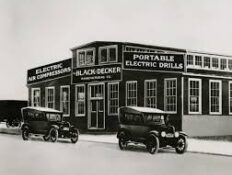
brizy_dc_post_title
We look into the history of power tools industry to trace when the top brands were born and when important power tools were invented.
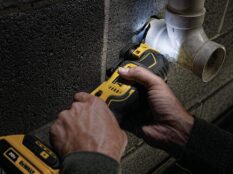
brizy_dc_post_title
From Fein to Makita, we compare 15 popular models for finding the best oscillating tool based on common applications.
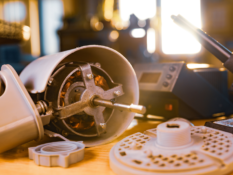
brizy_dc_post_title
A detailed look into the use of brushless motor technology in power tools and comparison of tangible vs. theoretical advantages.
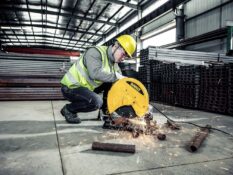
brizy_dc_post_title
Are you looking for the best chop saw for the money? In this post, we compare 7 popular models to find the best chop saw for metal.

brizy_dc_post_title
Dremel 8220 to Dremel 4300, we find the best dremel tool for your application from as well as the best rotary tool alternative to Dremel.

brizy_dc_post_title
We bring a complete guide on torque wrench calibration from the basic concept of calibration to calibration certificates, we explain it all.
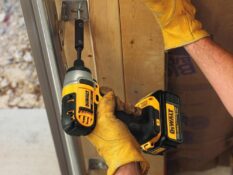
brizy_dc_post_title
We research the market to bring you the best impact driver for mechanics, woodworking, construction, HVAC and DIY applications.

brizy_dc_post_title
Our top picks for the best miter saw stand for each of professional, DIY, heavy duty and light applications from Bosch and Dewalt to Toughbuilt and Bora.
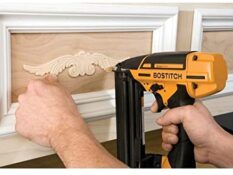
brizy_dc_post_title
Our top picks for the best brad nailer cordless & pneumatic for woodworking including baseboards, cabinets, trims, quarter rounds, crafts and DIY.

brizy_dc_post_title
We find the best torque wrench for different applications as cost effective alternatives to the premium Matco & Snap on torque wrench.
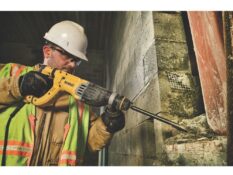
brizy_dc_post_title
Our take on the best hammer drill for applications ranging from construction work, concrete drilling & screwdriving anchor bolts to home use and DIY.

brizy_dc_post_title
Our recommendations on the best wire strippers for electricians, electronics technicians, HVAC technicians, auto electricians, DIYers & homeowners.

brizy_dc_post_title
We compare 9 models to find the best cordless circular saw for home use, professional use, framing and roofing.
